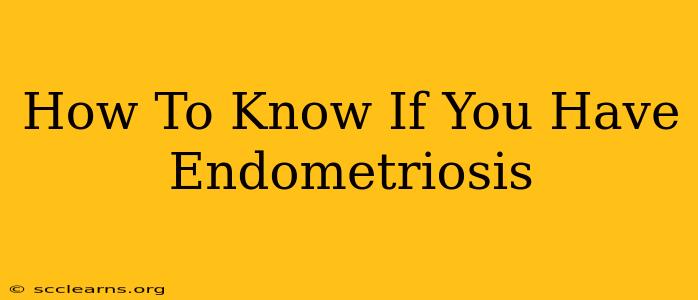Endometriosis is a condition where tissue similar to the lining of the uterus (the endometrium) grows outside of the uterus. This extra tissue can cause significant pain and other problems. Knowing the signs and symptoms is crucial for early diagnosis and management. This article will guide you through recognizing potential indicators of endometriosis, helping you make informed decisions about your health.
Understanding the Common Symptoms of Endometriosis
The symptoms of endometriosis can vary widely from woman to woman, and some women may experience no symptoms at all. However, several common signs should prompt you to seek medical attention.
Pain: The Hallmark Sign
Pain is a hallmark symptom of endometriosis. This pain can manifest in various ways:
- Pelvic pain: This is often the most prominent symptom, characterized by a dull, aching pain in the lower abdomen that can be constant or cyclical. It may worsen during menstruation.
- Dysmenorrhea (Menstrual Cramps): Women with endometriosis frequently experience extremely painful menstrual cramps that are significantly more severe than typical cramps. Over-the-counter pain relievers often provide insufficient relief.
- Dyspareunia (Painful Intercourse): Pain during sexual intercourse is a common symptom, stemming from the inflammation and presence of endometrial tissue in sensitive areas.
- Pain with bowel movements or urination: Endometrial tissue can implant itself on the bowels or bladder, causing pain during urination or bowel movements, particularly during menstruation.
Other Potential Indicators of Endometriosis
Beyond pain, several other symptoms might suggest endometriosis:
- Heavy Bleeding (Menorrhagia): Prolonged or excessively heavy menstrual bleeding is a common occurrence.
- Infertility: Endometriosis can interfere with fertility, making it difficult to conceive. This is due to inflammation and scarring caused by the condition.
- Fatigue: Chronic fatigue is a common complaint among women with endometriosis, often associated with the pain and hormonal imbalances.
- Bloating: Significant bloating, especially around menstruation, can be another indicator.
- Digestive Issues: Constipation, diarrhea, and nausea are also possible symptoms.
When to See a Doctor
If you're experiencing persistent pelvic pain, heavy bleeding, painful periods, or difficulty conceiving, it's crucial to consult a gynecologist or healthcare professional. Don't hesitate to seek medical attention, even if your symptoms seem mild. Early diagnosis and treatment can significantly improve your quality of life.
Diagnosis of Endometriosis
Diagnosis of endometriosis typically involves a combination of approaches:
- Pelvic Exam: A physical examination can reveal tenderness or abnormalities in the pelvic area.
- Imaging Tests: Ultrasound, MRI, or CT scans may be used to visualize the endometrial implants.
- Laparoscopy: This minimally invasive surgical procedure allows a direct visualization of the pelvic organs and confirmation of endometriosis. It's often considered the gold standard for diagnosis.
Living With Endometriosis: Management and Treatment
Treatment options for endometriosis vary depending on the severity of the symptoms and the individual's goals. Options range from pain management medication to surgery.
Remember: This information is for educational purposes only and does not constitute medical advice. Always consult a healthcare professional for accurate diagnosis and treatment of any health concerns. Early detection and appropriate management are key to effectively coping with endometriosis and improving your well-being.

